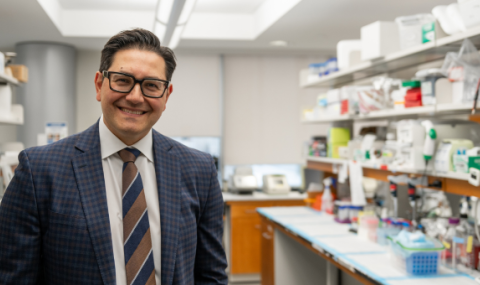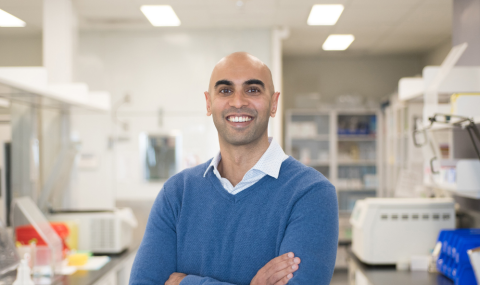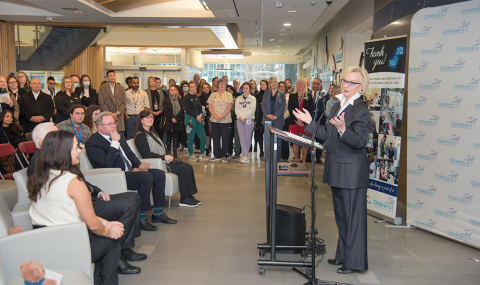MEDIA RELEASE
For Immediate Release:
May 30, 2011
- Media Release
- Media opportunities for June 5 perinatal transfer
- St. Joseph’s Perinatal and Neonatal Intensive Care Program
- Restructuring at London’s Hospitals
- Victoria Hospital’s north tower (zone B)
LONDON, Ontario –In just 7 days, the delivery of women's and children's care in the city of London will forever change with the transfer of all obstetrical care services, including high-risk antenatal care and the neonatal intensive care unit, from St. Joseph's Health Care, London to London Health Sciences Centre.
At noon on Saturday, June 4, 2011, St. Joseph's Hospital will stop admitting women in labour in preparation for the move to Victoria Hospital. The following day, June 5, will represent a significant milestone for both hospital organizations, as upwards of 40 to 60 patients, including the smallest and most fragile neonatal infants, are transferred from St. Joseph's Hospital to the new purposefully-built facility at Victoria Hospital. Impacted patients and families have been notified of this transfer as have expectant women that currently receive prenatal care at St. Joseph’s.
A physical relocation of this magnitude is a challenging task as there are many details to consider. Move teams consisting of staff and physicians from both organizations, Health Care Relocations, Middlesex-London EMS, Voyageur Patient Transfer Services and Campbell Bros Movers are working together to ensure the safe and seamless transfer of patients, staff and equipment.
The transfer of perinatal and NICU services is part of a larger acute care redevelopment project that has been taking place across the city hospital’s that is commonly referred to as Milestone 2, Phase 2 (M2P2) restructuring. As a significant part of the historic consolidation of women’s and children’s healthcare services, this will be one of the largest and most noteworthy moves taking place within the M2P2 project.
"This is a pivotal moment in the history of St. Joseph’s,” says Dr. Gillian Kernaghan, president and CEO of St. Joseph’s Health Care, London. “In 7 days we will say goodbye to services that have held a special place in the hearts of many as we proudly pass on to LHSC a program that offers a tremendous legacy of world-class excellence, compassion and success; one that has spanned more than 100 years and more than 100,000 births.”
"The transfer is about much more than the receiving of services,” says Bonnie Adamson, president and CEO, London Health Sciences Centre. “It represents years of collaboration and planning that will ultimately bring together the expertise of highly-skilled neonatal and obstetrical teams of nurses, physicians, specialists and support staff in a single purposefully-built facility where more than 6,000 babies will be delivered each year. It is with honour that we will welcome the St. Joseph’s program to the LHSC family and it is with excitement that we look forward to building upon the past and beginning a new legacy of women and children’s care for Londoners today and for future generations to come.”
Please note that there will be several move-day opportunities for the media on June 5th. We are pleased to offer a preview of the media opportunities in the attached chart. As well, please watch for
more detailed media advisories to be distributed later this week.
-30-
About London Health Sciences Centre
London Health Sciences Centre has been in the forefront of medicine in Canada for 135 years and offers the broadest range of specialized clinical services in Ontario. Building on the traditions of its founding hospitals to provide compassionate care in an academic teaching setting, London Health Sciences Centre is home to Children’s Hospital, South Street Hospital, University Hospital, Victoria Hospital, two family medical centres, and two research institutes – Children’s Health Research Institute and Lawson Health Research Institute, a joint research initiative with St. Joseph’s Health Care, London. As a leader in medical discovery and health research, London Health Sciences Centre has a history of over 50 international and national firsts and attracts top clinicians and researchers from around the world. As a regional referral centre, London Health Sciences Centre cares for the most medically complex patients including critically injured adults and children in Southwestern Ontario and beyond. The hospital’s nearly 15,000 staff, physicians, students and volunteers provide care for more than one million patient visits a year. For more information visit www.lhsc.on.ca.
About St. Joseph’s Health Care London
St. Joseph’s Health Care, London is a major patient care, teaching and research centre with a distinguished legacy of service to London, Southwestern Ontario and the veterans of Canada, dating back more than 130 years. St. Joseph’s five key role areas include acute/ambulatory care, complex care and veterans care, long-term care, rehabilitation and specialized geriatrics and specialized mental health care. Facilities and services including St. Joseph’s Hospital, Parkwood Hospital, Mount Hope Centre for Long Term Care and Regional Mental Health Care London and St. Thomas are part of the St. Joseph’s family. Our research arm, the Lawson Health Research Institute, continues to direct their research to the development of new knowledge that is continually being applied directly to patient care. More than 400,000 patients annually receive care from close to 6,000 physicians and staff at St. Joseph’s. St. Joseph’s is affiliated with the University of Western Ontario.
For media inquiries contact:
Mandy Merryweather
Citywide Communications Consultant – Restructuring
519-685-8500 ext. 75157, pager 17178
mandy.merryweather@lhsc.on.ca
Michele Martin
Citywide Communications Consultant – Restructuring
519.646-6100 ext. 64646, pager 16529
michele.martin@lhsc.on.ca
Media opportunities for June 5 perinatal transfer
The transfer of all obstetrical care services, including high-risk antenatal care and the neonatal intensive care unit, from St. Joseph’s Health Care, London to London Health Sciences Centre will take place on Sunday, June 5, 2011.
There will be a number of events for media to witness throughout the day, from 6:45am-2pm. The following is an overview of those activities. Please note that we will be distributing a detailed media advisory later this week that will outline these events.
| Event |
Approximate Time | Location |
| Witness the final shift change | 6:45am-8am | St. Joseph’s Hospital, Entrance A |
| Transport line-up departures from St. Joseph’s |
7:45am-2pm | St. Joseph’s Hospital, Wellington Road (Outdoor viewing area) |
| Departure and transport of the first neonatal infant | 8am | St. Joseph’s Hospital, Wellington Road (Outdoor viewing area) |
| Transfer of care ceremony / followed by interview opportunity with hospital spokespersons | 8:15am | Victoria Hospital, Zone B main entrance (Outdoor viewing area) |
| Transport line-up arrivals at Victoria Hospital | 8:15am-2pm | Victoria Hospital, Zone B main entrance (Outdoor viewing area) |
| Last baby born at St. Joseph’s Hospital | TBD | St. Joseph’s Hospital |
| Ceremonial closing of the lights in perinatal care | 2pm | St. Joseph’s Hospital |
Please note that a media release will be distributed on Sunday at the conclusion of the transfer.
St. Joseph’s Perinatal and Neonatal Intensive Care Program
Backgrounder
St. Joseph’s Hospital has enjoyed an illustrious history in providing care for families giving birth since the very first baby was born here more than 100 years ago. Through the years, St. Joseph’s celebrated many milestones and grew to become a world class centre in obstetrical care where more than 4,000 babies were born every year.
The Neonatal Intensive Care Unit (NICU) leaves a lasting memory of the 46 years of neonatal intensive care and its legacy of more than 25,000 children who survived critical illness and premature birth thanks to the excellent care received from the pioneers in this work and the health care teams that followed and excelled in neonatal care. The unit is the regional level III program serving Southwestern Ontario. Every year, 600-700 newborns have been cared for in the NICU. From there, most of these infants - born as early as 24 weeks gestation and weighing as little as 500 grams - have gone onto live active healthy lives.
Families across the region have also relied on the Family Birthing Centre, Mother Baby Care Unit, Antenatal Care, Developmental Follow-up Clinic and other essential services of St. Joseph’s perinatal program. All these services have helped shaped the care of women and newborns locally, provincially and across the country through discovery, education, and unparalleled compassion and care excellence.
The following are among more than a century of milestones in perinatal and neonatal care at St. Joseph’s:
October 5, 1901
The first recorded birth at St. Joseph’s Hospital was on October 5, 1901. There were a total of 13 births born that first year between Oct. 1, 1901 and Sept. 30, 1902. Most babies were born at home during these years.
1927
The Sewing Group began making booties, bibs and sweaters that were sold on the maternity floor with proceeds donated to the hospital.
1932
A new, three-story wing opened that included an obstetrical suite and nursery with space for 47 bassinets.
1962
Construction began on the Wellington Wing expansion. The third floor of this expansion was designed as the new location for obstetrics, where it would remain until today. The expansion opened in 1964.
1967
St. Joseph's internationally-renowned Neonatal Intensive Care Unit opened.
Mid 1970’s
Ultrasound imaging was first introduced.
1979
The Developmental Follow-Up Clinic was established. This program serves as an important surveillance program for the neurodevelopment of high- risk infants who have been cared for in the NICU.
1979
Regional Perinatal Outreach Program was initiated by Dr. Graham Chance. The goal was to assists hospitals in the region with education and consultation regarding maternal and newborn care in order to reduce perinatal morbidity, mortality, and the incidence of low birth weight.
1979
Glucocorticoids (steriods) were used for the first time to help bring on labour.
1980
Initial studies were performed using real time ultrasound to detail biological factors affecting human fetal behavioural activity and breathing movements.
1981
New NICU was built.
1982
Natural surfactant drug was introduced for the first time as replacement therapy for babies with immature lungs. It would become one of the most significant developments in the care of premature infants.
Mid-eighties
The Perinatal Loss Program became available for parents and families who lose a baby through early pregnancy loss, stillbirth or newborn death. The program offers support and comfort in helping families begin to heal.
1987
St. Joseph’s became the first in Canada to show that nuclear magnetic imaging would be able to discern fetal abnormalities.
1995
A group of nursing staff designed the first-ever attendant's role in the NICU. The role removed non-nursing tasks so that nurses could spend more time at the bedside of their babies and families.
1996
Care by Parent Unit opened to help newborns and their parents prepare for discharge from the NICU.
1999
A 3.0T MRI system was used for the first time for neonatal imaging.
June 4, 2011
St. Joseph’s Hospital ends admissions to the Family Birthing Centre at noon.
June 5, 2011
All obstetrical care services, including high-risk antenatal care and the neonatal intensive care unit will move to London Health Sciences Centre. This will bring all obstetrical care services in London together in one central location at Victoria Hospital.
Restructuring at London’s Hospitals
This June, Milestone 2, Phase 2 (M2P2), a joint restructuring initiative between London Health Sciences Centre and St. Joseph's Health Care, London will be completed. It will represent the largest hospital restructuring project in London's history.
M2P2 is part of a larger overall hospital redevelopment project to reorganize and align the delivery of acute care services in London. Since 1997, LHSC and St. Joseph’s have been working together to accomplish the following:
2008-2011
Milestone 2, Phase 2 began in 2008 and will be completed in June 2011. This Milestone includes 23 internal hospital moves and 5 clinical program transfers between LHSC and St. Joseph’s. Completion of M2P2 means we will have realigned and consolidated most of the clinical and support services between the two organizations so that each hospital will have a defined and distinct role – reducing duplication of work and improving the overall patient care environment. For a complete schedule of M2P2 moves, please visit: http://www.lhsc.on.ca/About_Us/Restructuring/Schedule.htm.
M2P2 also represents an unprecedented amount of construction as 106,000 sq. ft. of space was renovated at St. Joseph’s and the interior construction of the north tower was completed at Victoria Hospital. Total construction costs for Milestone 2, Phase 2 are $211 million for LHSC and $49 million for St. Joseph’s.
At the end of M2P2, we will see a consolidation of services, particularly in women’s and children’s programs, new and renovated spaces and improved patient care environments.
The completion of Milestone 2, Phase 2 does not mean the end of our journey to complete hospital renewal. Milestone 2 Phase 3, the final phase, will bring to a close the completion of the HSRC directives. M2P3 is set to begin this August, pending the expected project approval in July. It is anticipated that this final phase of acute care restructuring will be fully complete in 2015.
2007-2009
Milestone 2, Phase 1 began in 2007 and was focused on construction and renovations at various St. Joseph’s and LHSC hospital sites. Construction of the outer shell of the north tower at Victoria Hospital was completed in 2007. M2P1 also included the construction and renovation of at least 10 major care delivery areas along with clinical support services.
2006
In the time between the completion of Milestone 1 and the start of Milestone 2, St. Joseph’s Hospital celebrated the opening of the new Diagnostic Imaging Centre and the G.A. Huot Surgical Centre.
2003
Construction of the outer shell of the north tower at Victoria Hospital begins.
1998-2005
Milestone 1 began in 1998 and was completed in June 2005. This milestone represented 42 internal hospital moves and 23 clinical program transfers between LHSC and St. Joseph’s. It culminated in 2005 with the consolidation of emergency care, the creation of urgent care and the move of inpatient services, with the exception of acute mental health care, from the aging South Street Hospital facilities to Victoria hospital.
Construction costs for Milestone 1 were $216 million for LHSC and $69 million for St. Joseph’s.
1997
London Health Sciences Centre and St. Joseph’s Health Care, London began working together to reorganize and align the delivery of acute care services in London, as prescribed by the Health Services Restructuring Commission (HSRC) directives.
Victoria Hospital’s north tower (zone B)
What is the north tower?
The north tower is Victoria Hospital’s newest building. The 600,000 square foot, ten-story tower is representative of eight years of planning and construction. As a part of the hospital’s lettered way finding system, the north tower is referred to as zone B.
When was the north tower (zone B) built?
Construction of the outer shell of the north tower (zone B) began in 2003 and was substantively complete in 2007. Interior construction and infill of the north tower was completed largely on a top-down floor-by-floor basis and was fully complete in May 2011. The first inpatient was admitted to level 9 of the north tower on October 2, 2010.
Why was the north tower (zone B) built?
Development of the north tower (zone B) at Victoria Hospital was required in order for LHSC and St. Joseph’s to meet the directives mandated by the Health Services Restructuring Commission (HSRC) in 1997. New, larger spaces were needed to consolidate acute care services, meet today’s hospital building codes and infection control standards and allow for the decommissioning of patient care at the aging South Street Hospital facilities.
How much did it cost to build the north tower (zone B)?
The total building cost of the north tower (zone B), including financing, ancillary and construction was $360 million.
Construction costs for the entire physical building were shared with the Ministry of Health and Long-term Care. The cost for the exterior was shared 70/30 while the in-fill was shared 90/10.
The Ministry’s share funded construction of the base building, while the remaining costs were covered by a local share. The local share was provided through hospital funds that were explicitly earmarked for restructuring and generous donor support.
What programs are located in the north tower (zone B)?
As of June 17, 2011, the north tower (zone B) will be fully occupied with the following programs/services:
Level 10 Clinical laboratories
Level 9 Adult general and orthopaedic surgery inpatient unit
Level 8 Children’s Hospital child and adolescent mental health care
Level 7 Adult mental health care inpatient unit
Level 6 Children’s Hospital paediatric inpatient unit
Level 5 Women’s ambulatory care and medical genetics clinics
Level 4 The birthing centre and neonatal intensive care unit
Level 3 Ear, nose and throat clinic
Level 2 Patient Registration/admitting, nuclear medicine imaging, endoscopy, medical day unit and I.V. therapy, and urgent neurology clinic
Level 1 Children’s Hospital paediatric medical day unit and hospital pharmacy



